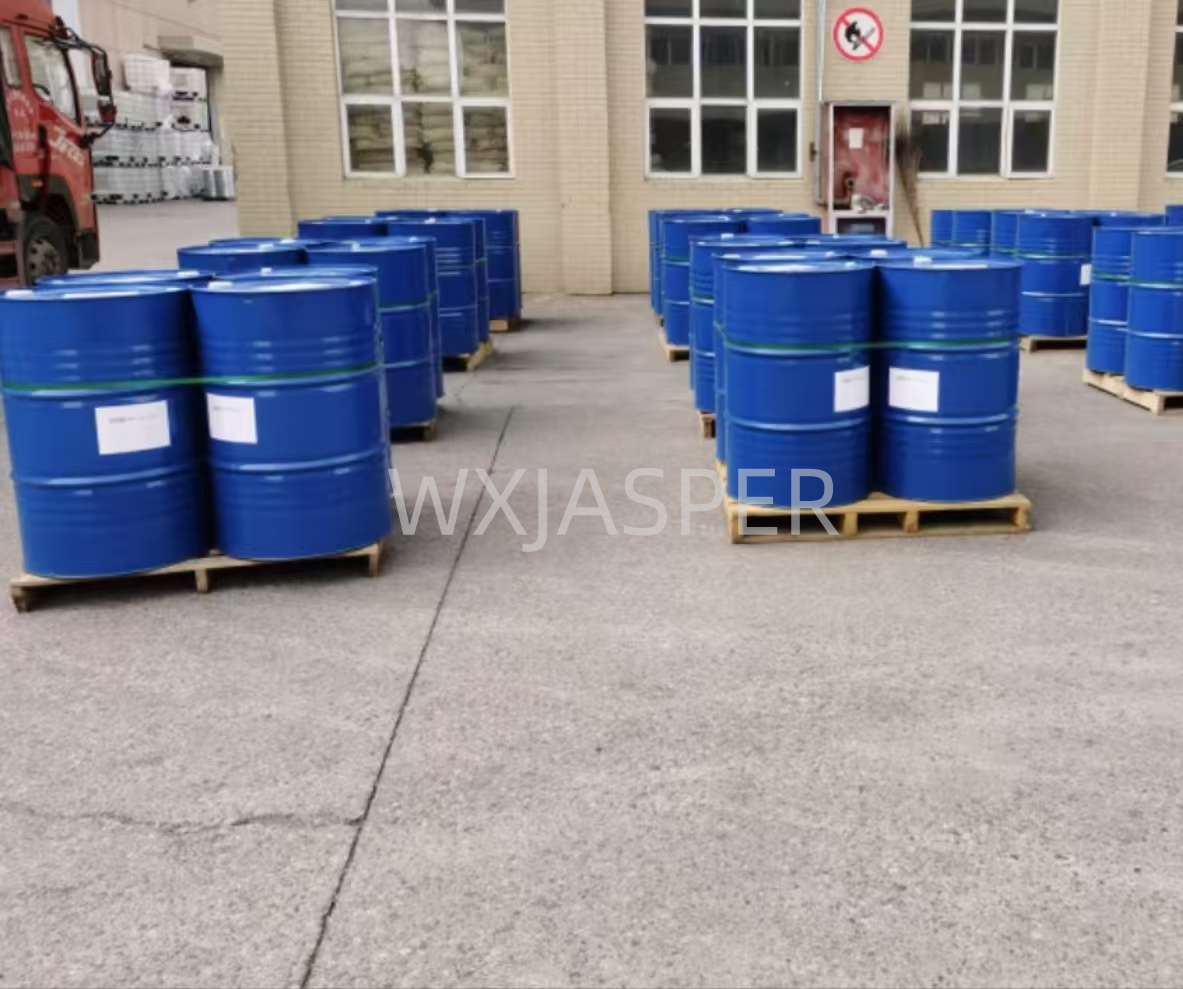Product Details
CasNo: 110-91-8
MF: Morpholine
Appearance: liquid
Delivery Time: 15 days
Packing: 200kg/drum
Purity: 99%
1. Basic Information
- CAS No.: 110-91-8
- English Name: Morpholine
- Synonym: 1,4-Oxazepane; Tetrahydro-1,4-oxazine
- UN Number: 1169 (Hazard Class: Class 3 Flammable Liquids; Packing Group: III)
- Appearance & Character: Colorless oily liquid at room temperature, with an ammonia-like odor.
- Melting Point: -4.6℃
- Boiling Point: 128.4℃
- Relative Density (Water = 1): 1.00 (at 20℃; density close to water, easy to mix with aqueous solutions)
- Relative Vapor Density (Air = 1): 3.0 (vapor is heavier than air, tends to accumulate in low-lying areas)
- Saturated Vapor Pressure: 0.93 kPa (at 20℃; low volatility compared to low-boiling ethers, but still requires ventilation control)
- Flash Point: 35℃ (closed cup; classified as a flammable liquid, requiring ignition source management)
- Explosion Limits: 1.8%–10.8% (volume fraction in air; moderate explosion range, with potential detonation risk in confined spaces)
- Solubility: Miscible with water; fully soluble in most organic solvents such as ethanol, ether, acetone, and benzene.
2. Chemical Properties
Morpholine contains a secondary amine group (−NH−) in its heterocyclic structure, giving it all the typical reaction characteristics of secondary amines:
- Acid-Base Reaction: Reacts with inorganic acids (e.g., hydrochloric acid, sulfuric acid) to form stable salts (e.g., morpholine hydrochloride); reacts with organic acids to produce salts or amides (e.g., reaction with acetic acid to form morpholine acetate).
- Alkylation Reaction: Under appropriate conditions, the nitrogen atom in the secondary amine group can undergo alkylation with alkyl halides (e.g., methyl chloride) to generate N-alkyl morpholine derivatives.
- Other Reactions: Reacts with ethylene oxide to form hydroxyethyl morpholine; undergoes condensation with ketones to produce imines; participates in the Willgerodt reaction (converting aryl alkyl ketones to aryl acetic acids).
- Stability: Chemically stable under normal temperature and pressure, but decomposes when heated to high temperatures (>300℃), releasing toxic gases such as ammonia and nitrogen oxides (NOₓ).
3. Core Applications
3.1 Rubber and Chemical Industry
- Rubber Additives: The most important application—used to synthesize rubber accelerators (e.g., CBS, NOBS) and vulcanizing agents. These additives improve rubber’s cross-linking efficiency, enhance its elasticity and wear resistance, and are widely used in tire, rubber seal, and hose production.
- Surfactants & Detergents: Used to produce corrosion inhibitors, scale removers, and rust preventives (e.g., morpholine oleate, which forms a protective film on metal surfaces to prevent oxidation). It is also an ingredient in industrial cleaners, effectively removing oil and dirt from metal parts.
- Polymer Catalysis: Serves as a catalyst for butadiene polymerization, promoting the formation of high-molecular-weight polybutadiene with controlled structure.
3.2 Pharmaceutical Industry
- Pharmaceutical Intermediate: A key raw material for synthesizing multiple important drugs, including:
- Antiviral drugs (e.g., moroxydine, also known as "Bingdu Ling," used to treat influenza and viral conjunctivitis).
- Non-steroidal anti-inflammatory drugs (e.g., ibuprofen, a common pain reliever and fever reducer).
- Antibacterial and antifungal drugs (e.g., morpholine derivatives with broad-spectrum antimicrobial activity).
3.3 Other Fields
- Textile & Printing: Used as a textile auxiliary (e.g., softener, dyeing accelerator) to improve fabric hand feel and dye adsorption.
- Optical Industry: As an additive in optical brighteners, enhancing the whiteness of paper, textiles, and plastics.
- Agriculture: Used to synthesize pesticide intermediates (e.g., morpholine-based fungicides) for crop disease prevention.
4. Safety Information
4.1 Health Hazards
- Inhalation: Vapor or mist strongly irritates the respiratory mucosa, causing bronchitis, pneumonia, or pulmonary edema; high-concentration inhalation can lead to death due to respiratory failure.
- Eye Contact: Vapor or liquid causes severe eye irritation, leading to redness, pain, and even blindness if not treated promptly.
- Skin Contact: Liquid contact can cause chemical burns (manifested as redness, blistering, and peeling); prolonged contact may lead to systemic absorption and toxic reactions.
- Ingestion: Swallowing the liquid burns the digestive tract (mouth, esophagus, stomach), causing nausea, vomiting, and bleeding; large doses can result in organ failure and death.
4.2 Fire and Explosion Hazards
- Flammable: Vapor can form explosive mixtures with air; contact with open flames, high heat, or electrostatic sparks (e.g., ungrounded equipment) can trigger combustion or explosion.
- Combustion Products: Toxic gases including carbon monoxide (CO), nitrogen oxides (NOₓ), and ammonia (NH₃) are released during burning, posing additional health risks.
4.3 Protective Measures
- Personal Protection: Wear a full-face self-priming filter respirator (to prevent inhalation of vapor), chemical-resistant overalls (e.g., nitrile rubber fabric) to avoid skin contact, and nitrile rubber gloves (latex gloves are not recommended, as they are permeable to morpholine).
- Workplace Safety: Use explosion-proof ventilation systems and electrical equipment (e.g., lamps, motors); install gas detectors to monitor morpholine vapor concentration (limit ≤ 20 ppm, 8-hour TWA). Prohibit smoking or eating in the work area; provide emergency eye wash stations and safety showers nearby.
5. Packaging and Storage
5.1 Packaging
- Reagent Grade (Small Volume): 100 mL, 500 mL, 1 L, or 2.5 L high-density polyethylene (HDPE) plastic bottles, with EPDM gasket-sealed caps to prevent leakage.
- Industrial Grade (Bulk): 200 kg epoxy resin-lined steel drums (to avoid metal corrosion by morpholine) or 25 L polyethylene/metallized polyester film drums. For large-volume supply, 1000 L IBC tanks (HDPE inner liner + steel frame) are available.
5.2 Storage
- Store in a cool, well-ventilated, explosion-proof warehouse with a temperature not exceeding 30℃. Keep away from ignition sources, heat (e.g., radiators), and direct sunlight.
- Seal containers tightly to prevent vapor leakage; store separately from strong acids (e.g., sulfuric acid), strong oxidants (e.g., hydrogen peroxide), and food chemicals to avoid reactions.
- Equip the storage area with dry powder fire extinguishers and foam fire extinguishers (water extinguishing is not recommended, as it may spread the liquid). Post warning signs such as "Flammable," "Corrosive," and "No Smoking."
5.3 Transportation
- Comply with hazardous chemical transportation regulations: Use explosion-proof vehicles with anti-static grounding devices; do not mix with other dangerous goods.
- Avoid severe collisions, exposure to sunlight, or rain during transportation. In summer, transport in the morning or evening to avoid high-temperature periods.


